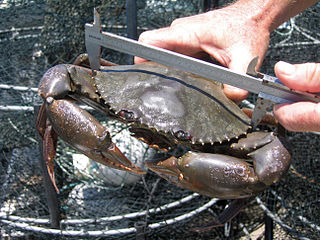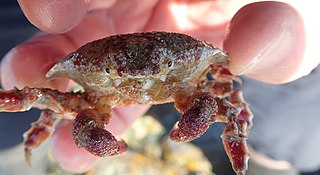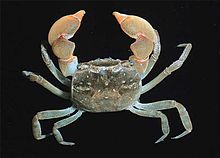
Scylla serrata is an ecologically important species of crab found in the estuaries and mangroves of Africa, Australia, and Asia. In their most common forms, their shell colours vary from a deep, mottled green to very dark brown.

Grapsus grapsus is one of the most common crabs along the western coast of the Americas. It is known as the red rock crab, or, along with other crabs such as Percnon gibbesi, as the Sally Lightfoot crab.

Hemigrapsus sexdentatus, also called the “common rock crab” or “common shore crab,” is a marine crab indigenous to the southern shores of New Zealand. This crab is a member of the Varunidae family in the order Decapoda.

The Smooth Shore Crab is a marine large-eyed crab of the family Grapsidae, found in New Zealand and the Juan Fernández Islands of Chile.

Plagusia squamosa is a marine crab of the family Plagusiidae, formerly considered a subspecies of Plagusia depressa. It is found in tropical Indo-Pacific oceans. P. squamosa's carapace is bumpy and quite coarse, seemingly scaly, leading to its common name: The Scaly Rock Crab.

The purple shore crab is a common crab of the family Varunidae that is indigenous to the west coast of United States, Canada, and Mexico. H. nudus was first described in 1847 by Adam White, and in 1851, James Dwight Dana formally classified the species. H. nudus is a small, amphibious crab that is similar physically and behaviorally to Pachygrapsus crassipes and Hemigrapsus oregonensis. The purple shore crab is generally a dark purple color with olive green, red, and white spots. Mating season for H. nudus begins in mid-winter and larval crabs undergo 5 zoeal stages and a juvenile stage. Adult crabs mainly feed on algae but will occasionally scavenge other animals. H. nudus prefers inter-tidal and sub-tidal zones, and it can oftentimes be found sheltering under rocks or other debris. H. nudus demonstrates complex compensatory mechanisms to counteract fluctuating salinity and water oxygen concentrations, permitting it to live in a variety of different environments.

Hemigrapsus oregonensis is a small shore crab of the family Varunidae; formerly classified under the family Grapsidae. It is known under several common names, including yellow shore crab, hairy shore crab, green shore crab, mud-flat crab, bay shore crab and Oregon shore crab. Despite its common name, the crab actually has a wide variety of coloration. It is found along the West Coast of the United States and Canada, specifically along shorelines and similar geographical areas. In 2009, H. oregonensis was included on a list of animals petitioning for the endangered species label, but there was not enough scientific information available for it to be considered as such, so it remains unevaluated to the present day.

Pachygrapsus crassipes, the striped shore crab or lined shore crab, is a small crab found on both rocky and hard-mud soft seashores of the northeastern and northwestern Pacific Ocean. In North America, this species occurs from central Oregon, south through California to near Ensenada, Baja California, Mexico. There is an isolated population with a wide range disjunction at Bamfield on Vancouver Island, Canada. The western Pacific population, including both Korea and Japan is isolated with a divergence time from the eastern Pacific population estimated between 0.8 and 1.2 Mya.

Minuca pugnax, commonly known as the Atlantic marsh fiddler crab, is a species of fiddler crab that lives on north-western shores of the Atlantic Ocean.

Aratus pisonii, commonly known as the mangrove tree crab, is a species of crab which lives in mangrove trees in tropical and subtropical parts of the Americas, from Florida to Brazil on the Atlantic coast. A.pacificus occurs from Nicaragua to Peru on the Pacific coast. A. pisoni feeds mostly on the leaves of the mangroves, but is an omnivore, and prefers animal matter when possible. A. pisonii and A. pacificus are the two species in the genus Aratus. The specific epithet pisonii commemorates the Dutch naturalist Willem Piso who travelled in Brazil in 1638 with Georg Marggraf.

Heloecius cordiformis is a species of semiterrestrial crab found in mangrove swamps and mudflats along the east coast of Australia. Adults are around 25 mm (1 in) wide, with males being larger and having larger and more conspicuously coloured claws. The males wave their claws to communicate with other crabs, giving them their common name of semaphore crab. They can breathe both in air and under water, and feed at low tide on detritus in the sediment. H. cordiformis is the only species in the genus Heloecius and the family Heloeciidae.

Mictyris longicarpus, the light-blue soldier crab, is a species of crab that lives on sandy beaches from the Bay of Bengal to Australia; with other members of the genus Mictyris, it is "one of the most loved crabs in Australia". Adults are 25 mm (1 in) across, white, with blue on their backs, and hold their claws vertically. They feed on detritus in the sand, leaving rounded pellets of discarded sand behind them. The males may form into large "armies" which traverse the beach at low tide, before the crabs dig into the sand to wait for the next low tide.

Johngarthia lagostoma is a species of terrestrial crab that lives on Ascension Island and three other islands in the South Atlantic. It grows to a carapace width of 110 mm (4.3 in) on Ascension Island, where it is the largest native land animal. It exists in two distinct colour morphs, one yellow and one purple, with few intermediates. The yellow morph dominates on Ascension Island, while the purple morph is more frequent on Rocas Atoll. The species differs from other Johngarthia species by the form of the third maxilliped.

Eurynolambrus australis, commonly known as the triangle crab, and by its Māori name riangi, is a small species of crab that is widespread throughout New Zealand. It is the only species in the genus Eurynolambrus.
Coenobita pseudorugosus is a species of terrestrial hermit crab, family Coenobitidae.

Pseudohelice subquadrata is a species of crab in the family Varunidae. It is found from the eastern Indian Ocean to the western Pacific Ocean, north to Japan, south to Eastern Australia, east to French Polynesia, west to Indonesia and Thailand. It lives near mangroves, burrowing in firm soils, firm muddy sand or loose stones. Burrows are towards or above the high tide line on shores of estuaries and near river mouths of bays, and can have offshoots horizontal beneath the surface as long as three metres.

Helopgrapsus haswellianus, or Haswell’s shore crab, is the sole species of crab in the genus Helograpsus. It lives in river mouths and bays on the eastern coast of Australia. The carapace is strongly convex with one distinct notch behind the eye. Adult males have larger claws than adult females. The carapace is olive, dark slate grey or reddish. Claws of adult males are orange-yellow. Carapace size is up to 30 mm wide. The orange color is stronger when these crabs live in habitat with lower pollution levels.

Paragrapsus laevis is a species of crab found in south eastern Australia, from southern Queensland to around the South Australian border, including Tasmania.

Ghatiana atropurpurea is a species of arboreal crab from India that was first identified in 2016. Unlike other species of its genus, Ghatiana, it is not endemic to the Western Ghats.

Leptograpsodes octodentatus, known as the burrowing shore crab, is a species of crab in the superfamily Grapsoidea, It is the only species in the genus Leptograpsodes, and the family Leptograpsodidae.



















